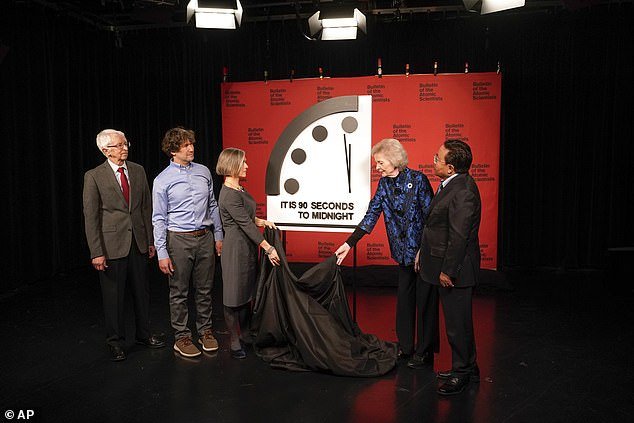The doomsday clock moves to 90 seconds before midnight, the closest it has been in 76 years.
>
BREAKING: ‘A Moment of Unprecedented Peril’: The Doomsday clock sits just 90 seconds before midnight because of the war in Ukraine – the closest humanity has come to annihilation in 76 years
- The Doomsday Clock has moved to just 90 seconds past midnight.
- This is a loss of 10 seconds compared to 2022, the scientists announced Tuesday.
- The change is due to the war in Ukraine and the threat of nuclear weapons from Russia.
The Doomsday clock is the closest it has come to a global catastrophe after this annual update on Tuesday that brought the hypothetical timer to 90 seconds to midnight.
The change is due in large part to the war in Ukraine, which the Bulletin of Atomic Scientists’ Board of Science and Safety fears will continue for a second year.
This potentially catastrophic event adds to Russia’s threats to use nuclear weapons, reminding the world that escalation of the conflict is a terrible risk.
This is the closest humanity has come to annihilation since the first nuclear bombs were dropped at the end of World War II, scientists sadly announced.
The Doomsday clock is the closest it has come to a global catastrophe after this annual update on Tuesday that pushed hypothetical timekeepers 90 seconds to midnight.
Every January since 1947, the Bulletin has revealed just how close humanity is to annihilation.
And in 2022, the clock ticked 100 seconds to our doom.
The clock was founded by American scientists involved in the Manhattan Project that led to the first nuclear weapons during World War II, and is a symbolic countdown to represent how close humanity is to completing the global catastrophe.
Artist Martyl Langsdorf was commissioned to make the clock and told to create an image that would “scare men into being rational,” according to Eugene Rabinowitch, the first editor of the Bulletin of Atomic Scientists.

The change is due in large part to the war in Ukraine, which the Bulletin of Atomic Scientists’ Board of Science and Safety fears will continue for the second year in a row.
Time is determined by the group of scientists who observe events throughout the year.
This can include politics, energy, weapons, diplomacy, and climate science, along with potential sources of threats such as nuclear threats, climate change, bioterrorism, and artificial intelligence.
And it has been put back and forth 24 times since 1947.
However, Tuesday marks the closest the clock has gotten to midnight.
